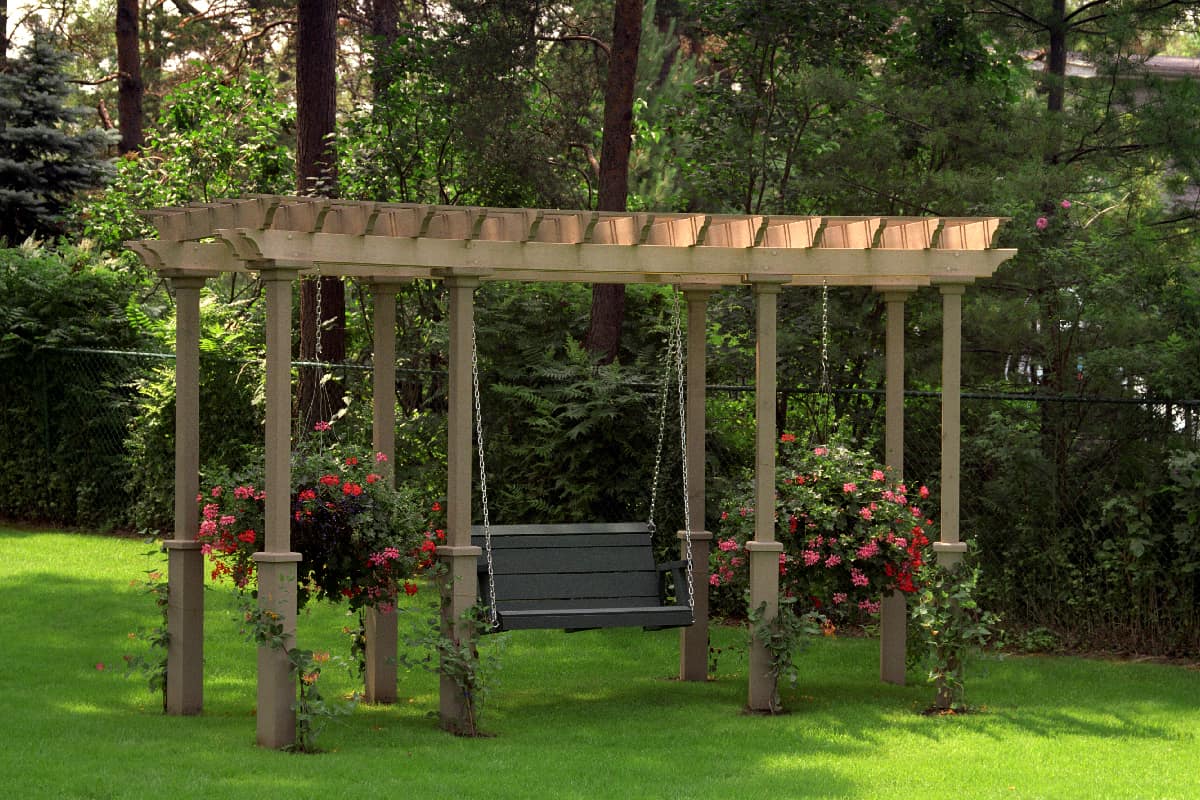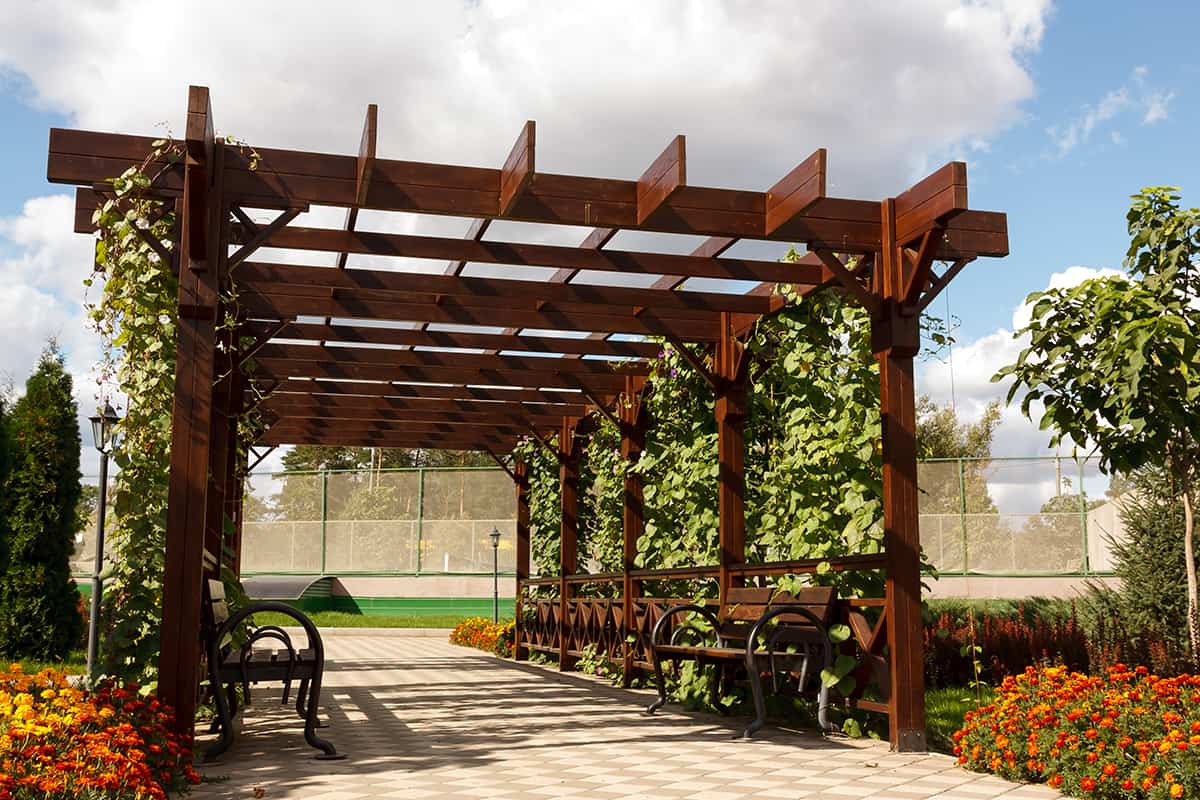Did you just finish your pergola project, and you’re wondering how to hide the concrete footing? Wonder no more, for we have researched this question, and we have the answer for you.
One of the easiest ways to hide the footing of your pergola is to decorate it with a hemp rope. Wrap the cylindrical concrete footing with hemp rope, including the first few inches of the column.
There are many ways to cover the footings that will add a decorative touch to your pergola. Learn all about them in the succeeding sections.
Read on!

Does a pergola need footings?
If you haven’t started building your pergola yet, you’d probably be relieved to know that footings are not a requirement for a pergola. Concrete footings help make your pergola stable, but it is not the only way to make your pergola sturdier.

Deeper Footing
You can dig a slightly deeper hole so that you can cover the footing with soil once it hardens. The advantage of deeper footings is that the columns of your pergola will look more natural without the concrete base. This is ideal if you’re going to install your pergola in the middle of a garden.
Without a visible footing above ground, you don’t have to worry about hiding it after installation.
Deeper Posts
It is possible to install a true concrete-free pergola.
If you are going this route, bury a quarter of the total length of the column under the ground. Find out if your local building code has a prescribed depth for columns of structures like a pergola. If your local building code has a depth requirement, make sure that the height of your column is not higher than three times the required depth.
Pergola And Patio

Another way to secure your pergola is to bolt them to an existing concrete patio.
A patio made with pavers is not sturdy enough to support a pergola unless it is built over a concrete slab. You can bolt the columns to the concrete that will serve as the footing of the pergola.
Use A Galvanized Concealed Post Base
One disadvantage of installing your pergola on a patio is that the bracket that secures the columns to the patio will be visible. Although it will not be as glaring as a concrete footing, it will still be out of place—especially for a patio and pergola that is in the middle of a beautiful garden.
Enter the concealed post base.
This type of base is a metal bracket that you can use to secure a column to a footing. Although in this situation, you will use the center bracket to secure the column to the patio.
Instead of having two metal plates to hold the two sides of the column to the patio, the center of this base will go in the middle of the column. The column will cover the bottom plate that you will bolt into the patio.
This type of bracket will make the wooden column of your pergola blend more easily with your patio and garden because there will be no metal brackets visible after you install the column.


Simpson Strong-Tie ZMAX Galvanized Concealed Post Base is available on Amazon through this link.
How to hide pergola footings?
If it’s too late to hide the footing during the construction of your pergola, you can still hide it after you complete the construction. You’re not even stuck to just the hemp rope design above.
Here are several ideas for hiding the concrete footing of your pergola.
Planter Footing

Another way of concealing the footing of your pergola is to turn it into a planter.
You can buy a square planter, cut it in half and then reassemble it over the footing. Secure the two halves of the planter from the inside so that it will be hidden too. Apply some wood filler over the cut, then paint it with a color that matches the color of your pergola.
Alternatively, you can use a DIY planter that you can design and decorate to match your pergola.
You can choose vines that will later climb up your pergola, decorating it from the columns as it grows. You can even plant flowers at the base of the vines to add color to your pergola.
Stylize the planter with strips of wood laid horizontally, or you can install them in a pattern.
Stone Footing
If the footing is not too high above the ground, you can use stones to cover it and stylize the base of your wooden columns. You can use different stone configurations based on the style that you want for your pergola.
You can use smooth stones, rough stones, small stones, or large stones. Lay them on the footing in random order or lay them in a decorative pattern. You can also mix stone sizes to give it a unique feel.
Gabion Footing
This method is taking the stone idea to the next level.
Traditionally, a gabion is a cage that you fill with rocks. You can build one over the footing using a wire mesh and then fill it with various types of stones.
Build a small gabion to cover the footing of your pergola. Use stones of a single color or mix them to give them character.
A gabion on your pergola will be ideal if it is installed close to a beach or a lake. You can even use a gabion for a pergola with a stone barbecue pit that uses the same type of stones.
Crystal Footing
You can install a shallow planter and then fill it with colorful pebbles or bits of colored glass. The planter is ideally made of clay, ceramic, or concrete although a wooden one will still do. Paint the planter will attractive colors that will contrast with the crystals that you will put in it.
If you’re handy with wires, you can place LED lights at the bottom of the planter before you fill it with crystals. Turn the LED on just before the sunsets for that magical effect on your pergola!
Brick Base
You can cover the footing with bricks to give the wooden column a gothic look. It doesn’t even have to be real bricks. You can use 3D stone panels or cladding to decorate the base of your wooden columns and hide the footer at the same time.
A stone veneer or cladding is normally used as a decorative layer for buildings. However, in this case, you can use it as a decorative cover for the footing of your pergola.
Match the color of the bricks with the color of the wooden column. Add a small overhang at the top to give it a more professional-looking finish.
You can make it as low as a few inches, just enough to cover the footing. Or you can make it as high as a few feet.
A higher version can have a layer over the column to support the veneer, or you can install the bricks over the wooden column.


Smart Profile’s 3D Wall Panels are available on Amazon through this link.
Wooden Basin
Here is another version of the planter idea.
Instead of using a regular planter, you can use a wooden basin to cover your footing.
Remove the bottom of the wooden basin and place it over the footing to cover it. You can then fill it with soil to use as a planter for vines and flowers, or you can fill it with stones.
You can even fill it with both.
Picket Fence
Build decorative picket fences that you can wrap around the footing to cover it. The inside space of the picket fence can be filled with a layer of soil then you can plant vines or other decorative plants. Vines are ideal because they can climb over the fence and the wooden column of your pergola and provide a natural decoration that will blend the fence and the column.
Conclusion

The best way to hide the footing of your pergola is to construct the column in a way that will bury the footing. If this is no longer possible, hiding the footing by decorating the base of the column is the best approach.
If you enjoyed reading this article, you might find the articles below equally enjoyable to read:

![A man using a portable vacuum to collect dead leaves, Will A Leaf Vacuum Pick Up Mulch? [Can It Remove Leaves From Mulch?]](https://landscapingbase.com/wp-content/uploads/2022/09/Man-using-a-portable-vacuum-to-collect-dead-leaves-600x400.jpg)

